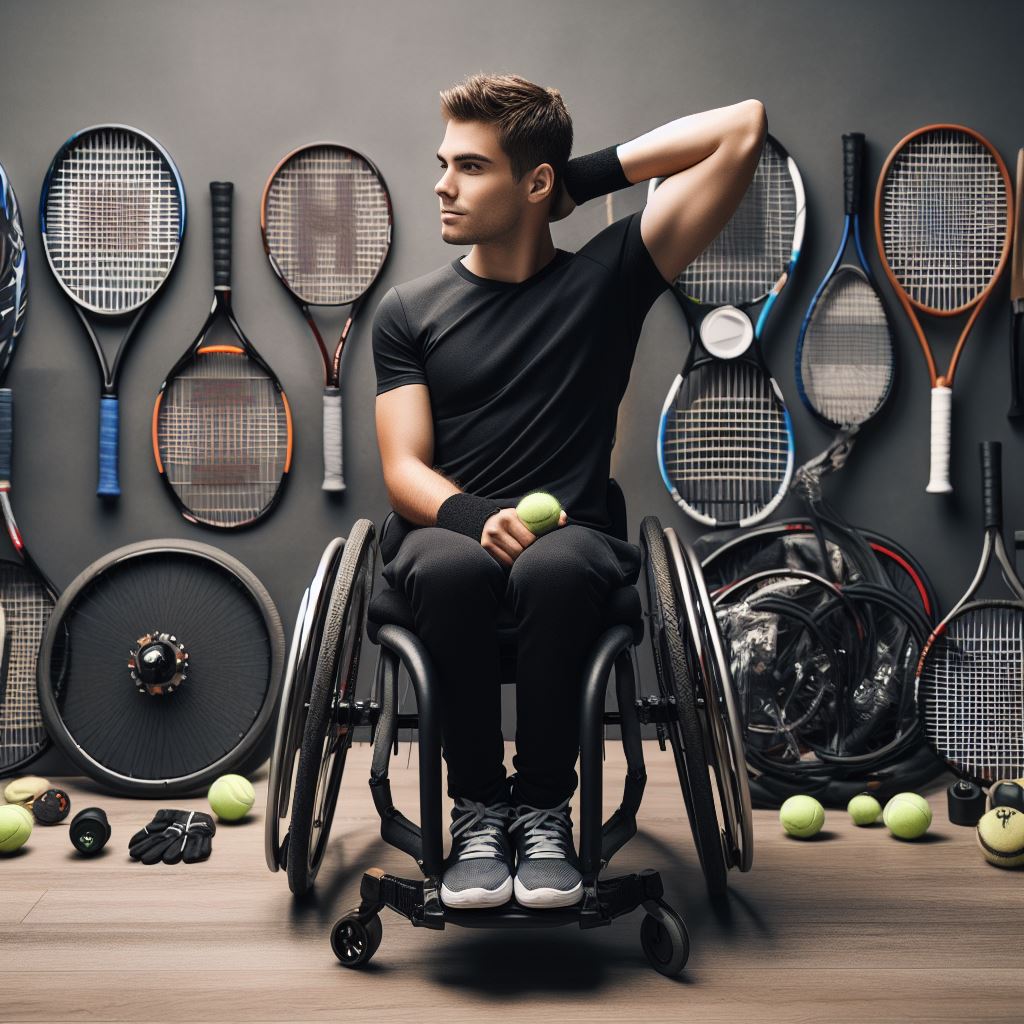Are you ready to take your wheelchair tennis game to the next level?
Look no further than this comprehensive guide to wheelchair tennis equipment.
From specialized wheelchairs designed for optimal maneuverability on the court, to high-performance racquets that offer maximum power and control, we’ve got you covered.
Discover the right balls, court accessories, and protective gear to enhance your game and keep you safe.
Get ready to dominate the court with this ultimate guide to wheelchair tennis equipment.
Key Takeaways
- Wheelchairs are modified for maneuverability, speed, and control with features like anti-tip bars and cambered wheels.
- Specialized racquets are designed for optimal performance and control, with factors like weight, balance, and grip size affecting speed and ball control.
- The choice of ball is crucial and depends on factors like playing surface, skill level, playing style, and weather conditions.
- Court maintenance accessories like drag brushes, squeegees, and court rollers help maintain a smooth and safe playing area, while equipment storage options keep gear organized and protected.
Wheelchairs
Wheelchairs are an essential piece of equipment in wheelchair tennis, providing players with the mobility and stability necessary to compete at a professional level. To enhance the performance of wheelchair tennis players, several modifications are made to the standard wheelchair design. These modifications aim to optimize maneuverability, speed, and control.
One important modification is the addition of anti-tip bars, which prevent the wheelchair from tipping backwards during sudden movements or aggressive strokes. This ensures player safety and stability on the court. Another modification is the installation of cambered wheels, which are angled outward from the center of the wheelchair. This design allows for better traction and stability when making quick turns or lateral movements.
In terms of wheelchair tennis technique, players rely on a combination of upper body strength, balance, and coordination. The wheelchair acts as an extension of the player’s body, allowing them to generate power and control in their shots. Players use their arms and shoulders to propel the wheelchair and position themselves to hit the ball effectively.
Furthermore, the wheelchair’s lightweight construction and adjustable features allow players to customize their seating position for optimal comfort and performance. This includes adjusting the seat height, backrest angle, and footrest position to meet individual needs and preferences.
Racquets
Wheelchair tennis players frequently rely on specialized racquets designed for optimal performance and control on the court. These racquets are specifically designed to accommodate the challenges faced by wheelchair users, providing them with the necessary tools to excel in the sport.
When it comes to wheelchair tennis techniques, the racquet plays a crucial role in executing shots with accuracy and power. The weight and balance of the racquet are important considerations, as they affect the player’s ability to generate speed and control the ball. Additionally, the grip size should be appropriate for the player’s hand size and comfort.
Wheelchair tennis training programs often include sessions dedicated to improving the player’s racquet skills. These programs focus on developing proper stroke mechanics, footwork, and agility, all of which contribute to effective racquet control. Coaches may also provide guidance on selecting the right racquet based on the player’s individual needs and playing style.
In the next section, we will explore the importance of choosing the right balls for wheelchair tennis. The choice of balls can significantly impact the game, affecting factors such as bounce, speed, and durability.
Balls
Choosing the appropriate ball is a crucial decision in wheelchair tennis, as it significantly impacts the game’s dynamics and performance. Wheelchair tennis ball types are designed to meet the specific needs of players, taking into consideration the unique factors of the sport. When selecting the right ball, there are a few techniques to consider.
Firstly, the surface on which the game will be played is an important factor. Hardcourt surfaces, such as concrete or asphalt, require a ball with a harder and more durable outer shell. On the other hand, clay or grass surfaces require a softer ball to ensure optimal bounce and control.
Another technique for selecting the right ball is to consider the player’s skill level and playing style. Beginners or players with limited upper body strength may prefer a ball with a slower pace and less bounce, allowing for easier control and longer rallies. More advanced players, on the other hand, may opt for a faster-paced ball that provides greater power and spin potential.
Lastly, the weather conditions should also be taken into account. In hot and humid climates, balls tend to become heavier and slower, while in colder conditions, balls may become harder and faster.
Court Accessories
When considering the equipment needed for wheelchair tennis, it is important to also take into account the various court accessories that can enhance the overall playing experience. These accessories not only contribute to the maintenance of the court but also provide convenient storage for equipment.
Here are some court accessories that wheelchair tennis players should consider:
- Court maintenance: Court maintenance accessories include drag brushes, squeegees, and court rollers. Drag brushes are used to maintain the smoothness of the court surface by brushing away any debris or loose particles. Squeegees are helpful for removing water or other liquid substances from the court, ensuring a dry and safe playing surface. Court rollers are used to compact the court surface, ensuring a consistent and level playing field.
- Equipment storage: Equipment storage accessories are essential for keeping your tennis gear organized and protected. Equipment carts and racks provide a convenient place to store and transport tennis balls, rackets, and other equipment. These storage options help prevent damage to your gear and make it easier to access everything you need for a match.
With these court accessories, wheelchair tennis players can ensure proper court maintenance and keep their equipment in excellent condition.
Now, let’s move on to the next section, which focuses on the importance of protective gear in wheelchair tennis.
Protective Gear
To ensure player safety and prevent injuries, proper protective gear is essential in wheelchair tennis. The right equipment not only provides necessary protection but also allows players to perform at their best without compromising their safety. When it comes to protective gear, there are a few key items that wheelchair tennis players should consider.
One of the most important pieces of protective gear is a helmet. A well-fitting helmet can protect the head from potential injuries during falls or collisions on the court. It is important to choose a helmet that is the right size to ensure proper fit and maximum protection.
Another essential piece of protective gear is wrist guards. These guards offer support and help prevent injuries to the wrists and hands. They are particularly important for players who have limited mobility or strength in their upper body.
Lastly, knee and elbow pads are crucial in protecting the joints during intense gameplay. They provide cushioning and absorb impact, reducing the risk of injuries such as bruises, scrapes, or fractures.
In summary, protective gear plays a vital role in wheelchair tennis, helping prevent injuries and ensuring player safety. When selecting gear, it is crucial to choose the right size and consider the specific needs of the player. By investing in high-quality protective gear, wheelchair tennis players can enjoy the game with confidence and peace of mind.
| Protective Gear | Purpose | Choosing the Right Size |
|---|---|---|
| Helmet | Protects the head | Measure head circumference to determine size |
| Wrist Guards | Supports wrists and hands | Measure wrist circumference to determine size |
| Knee and Elbow Pads | Cushions and absorbs impact | Measure knee/elbow circumference to determine size |
Frequently Asked Questions
What Are the Different Classifications of Wheelchair Tennis Players?
Different categories of wheelchair tennis players are determined based on their level of functional ability. The classification system evaluates players’ mobility, coordination, and strength, allowing for fair competition across various skill levels in the sport.
How Do I Choose the Right Wheelchair Tennis Tournament to Participate In?
When choosing a wheelchair tennis tournament to participate in, it is important to consider factors such as level of play, location, and competition format. Researching tournament requirements, preparation techniques, and what to expect can help athletes make an informed decision.
Are There Any Specific Rules or Regulations for Wheelchair Tennis Matches?
Wheelchair tennis matches adhere to specific rules and regulations regarding classification, tournament selection, strategies, techniques, skill improvement, performance enhancement, match conduct, and player eligibility. These guidelines ensure fair and competitive play in the sport.
What Are Some Common Strategies and Techniques Used in Wheelchair Tennis?
In wheelchair tennis, players employ various strategies and techniques to gain a competitive edge. These may include effective shot placement, utilizing spin and power, employing tactical positioning, and adapting to the opponent’s playing style.
How Can I Improve My Wheelchair Tennis Skills and Performance?
To improve wheelchair tennis skills and performance, focus on wheelchair tennis training tips such as improving mobility, strength, and agility. Additionally, mental preparation for wheelchair tennis competitions is crucial, including goal-setting, visualization, and managing pressure.
Conclusion
In conclusion, wheelchair tennis equipment plays a crucial role in enabling individuals with disabilities to participate and excel in the sport. Through the use of specially designed wheelchairs, racquets, balls, and court accessories, players are able to compete on an equal playing field.
Despite potential objections regarding the cost or availability of such equipment, it is essential to prioritize inclusivity and provide opportunities for all individuals to engage in wheelchair tennis, fostering a sense of empowerment and unity within the community.








No Comment! Be the first one.